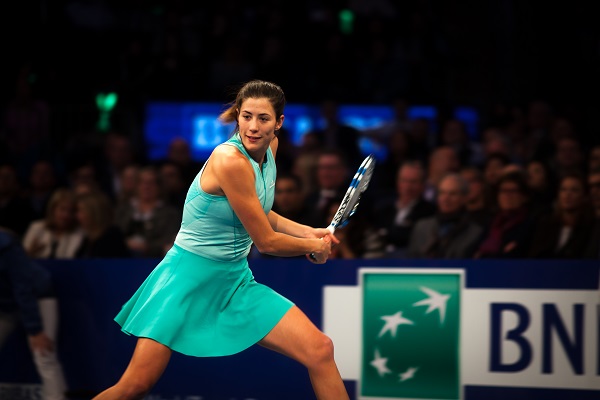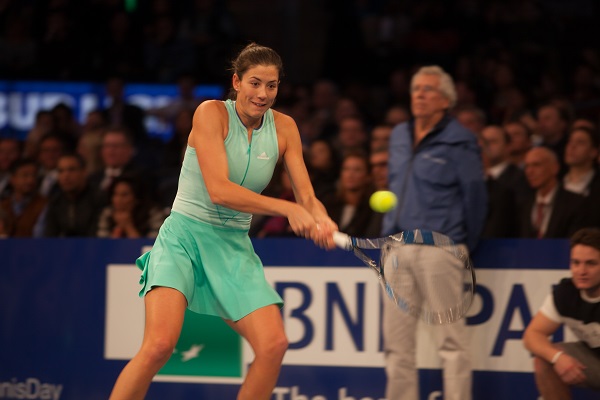Mighty Muguruza: Spaniard Seeks to Defend French Open Crown

Last year, 22-year-old Spaniard Garbine Muguruza became a household name by defeating Serena Williams to win the French Open title, becoming the first woman from Spain to win a major title since Arantxa Sanchez Vicario won the last of her four Grand Slam titles on the same Roland Garros clay.
“For Spanish people, this is THE tournament,” Muguruza said after hoisting the trophy. “When you’re a kid and practice on clay, you’re always, ‘Oh, I wish I could win Roland Garros.’”
Muguruza was actually born in Caracas, Venezuela to a Spanish father and a Venezuelan mother. She began playing tennis at just three-years-old and soon after, would move with her family to Spain where her tennis training really took off.

Training in Spain prepared her for success on clay. She is a product of the famous Bruguera Tennis Academy just outside of Barcelona, ran by Lluis Bruguera, the father of Sergi Bruguera, who won back-to-back French Open titles in 1993 and 1994, and the man many consider to be the father of modern Spanish tennis.
Muguruza began training at the Academy with her two older brothers when she was just seven-years-old, and immediately exhibited a competitive nature and work ethic which impressed Lluis.
Despite some early losses as a junior, Bruguera knew that Muguruza had what it took to become a top player on the WTA Tour. So it surprised no one when she claimed her maiden major title on the familiar red clay, a surface where she harnessed her determination and willingness to fight.
“She learned tactics, consistency, movement and footwork, patience, stamina and sacrifice, all hallmarks of the Spanish training system,” Chris Lewit, who is trained in the Spanish method, told WorldTennisMagazine.com.
What may have been a bit of a surprise in that French Open final was the way in which she dismantled Williams. The year prior, Muguruza fell to her in the Wimbledon final, but was able to learn from that defeat and move forward.
“I just thought at Wimbledon, I was very nervous,” she recalls. “I put that aside. I was like, ‘Come on, let’s go for it.’”
That mentality led her to a 7-5, 6-4 triumph over Williams, and at just 22 years of age, it looked as if it was just the first of many Grand Slams to come, an opinion shared by Sanchez-Vicario.
“She likes to play top players and is probably the up-and-coming player I see is improving each year,” Sanchez-Vicario said. “She has the level, the game. She just needs to get more consistent throughout the year, and mature as well. Once she gets that, she will be even more dangerous.”
But that consistency is something she has struggled with in the time since that Roland Garros triumph.
In her first match after winning the French Open, she lost to Kirsten Flipkens in the opening round in Mallorca, and then headed to Wimbledon. She entered the All-England Club as the defending runner-up, got past Camila Giorgi in three sets in her opener, before taking on 124th-ranked Jana Cepelova of Slovakia.
Muguruza put forth one of the poorest performances of her career and was dispatched by Cepelova in straight sets, winning just five games overall in the match.
After the loss, she reflected on the whirlwind she had gone through after winning the French Open, and evaluated how much more difficult things can get after reaching the top.
Jumping into a hectic schedule immediately after winning the French Open may have fatigued Muguruza both mentally and physically.
“[It’s not so much] more expectations from other people,” said Muguruza. “But honestly, for me, I was very clear it was going to be a rough tournament for me after winning a Grand Slam and coming here [Wimbledon] with everybody looking at me. I know all the matches are very tough. Nothing is going to happen if I lose today. It’s normal. It’s part of the game. I think it’s part of being at the top level. I would not change that. I know every time I step on the court, they want to beat me. They play loose because they have nothing to lose. But I like that. It [means I am] in a good situation.”
Muguruza would once again bow out early at the next Grand Slam, dropping a 5-7, 4-6 match to Anastasija Sevastova in the second round of the U.S. Open, and it seemed as if, despite her saying she relished in being the hunted and not the hunter, that the pressure of being a major champion could be having an effect.
“I don’t think about the French Open at all. It’s in the past. Everybody’s looking forward to the next one, the next tournament,” she said after the U.S. Open defeat. “Of course you have in your mind it’s a great achievement. No matter what, it’s a Grand Slam trophy. But I’m not thinking at all when I come here that I won the French Open. This is a new tournament.”
She would finish 2016 playing up and down tennis, which included losing two of her three matches at the WTA Finals in Singapore, and headed into 2017 looking to reclaim the fearless playing style that led her to the title at Roland Garros. She notched the best performance of her career down under by reaching the quarterfinals at the Australian Open, and would go on to reach the quarterfinals in Indian Wells.
Now, as the tennis year shifts to the clay-court season, we should see the Muguruza that became a household name with her triumph at Roland Garros a year ago. She is currently ranked sixth in the world, and the WTA field could be vulnerable to another deep run from the Spaniard.
Her opponent in last year’s final, Williams, is out for the rest of the year after announcing her pregnancy, and with Angelique Kerber playing inconsistently, Muguruza, despite her own inconsistent play, could find herself as one of the favorites heading into Roland Garros.
She was born and bred to play on the clay, and she will use that training as well as her past triumphs to once again seek a deep run at the French Open.
“I spent a lot of hours playing on clay when I was younger,” she said. “I was brought up on clay, so every time I go back to it I feel: ‘This is my territory.’ I know some people think that my game style is not ideal for clay, but I think I play well on it.”







